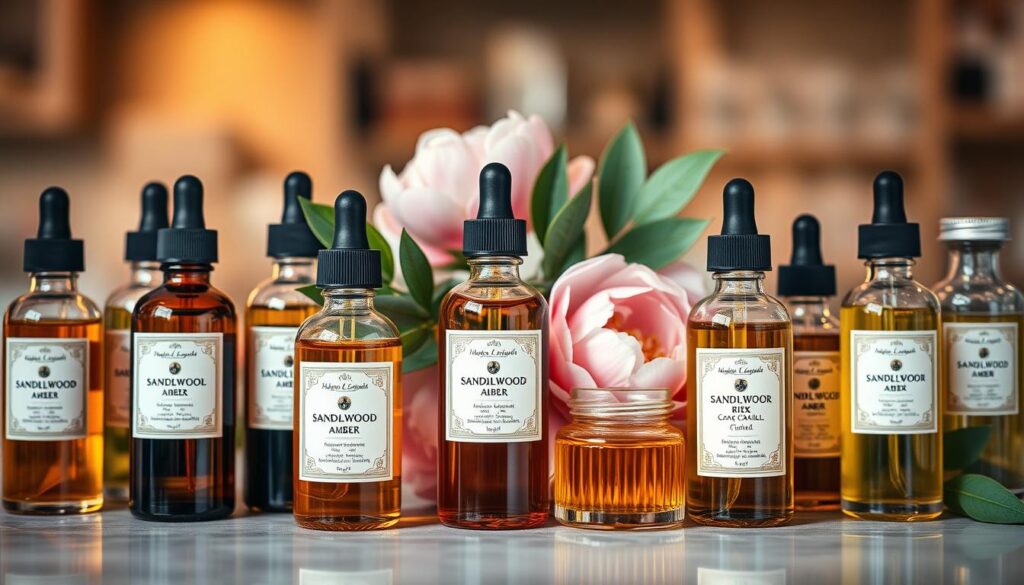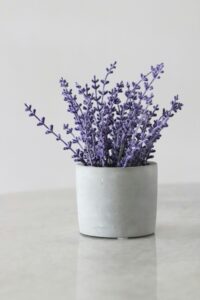We’ve all had that moment—a soft scent that takes us back or excites our senses about the future. There’s a complex mix of perfume oils and traditional spray fragrances behind that unique scent we like. It’s not just about a smell; it’s about the journey of the scent. It wraps us in an intimate scent experience that feels as secret as a whisper.
For centuries, perfume oils have done more than just make us smell good; they leave a unique mark, staying in rooms long after we leave. On the other hand, traditional spray fragrances fill the air, announcing us before we enter. Yet, perfume oils, even if less noticed today, remain a symbol of personal taste and quiet enjoyment.
To grasp this subtle power, we start by understanding scent structure. We learn about top, middle, and base notes. This is how scent becomes not just an add-on but a silent partner, part of our very essence.
Key Takeaways
- Top notes are the first scent burst, lasting about 5 to 15 minutes.
- Middle notes, making up 70% of the scent, stay from 20 minutes to an hour and form the main aroma.
- Base notes, with their deep smells, keep the fragrance going for up to 6 hours.
- Getting the right mix of top, middle, and base notes is key for a full, appealing scent.
- Natural perfume oils offer a lasting scent and a personal connection to our senses, without overwhelming others.
- Knowing the parts of a fragrance helps us choose personal scents wisely.
What are Fragrance Notes?
Fragrance notes are layers that make up the scent of perfumes and colognes. Each layer reveals a different part of the scent experience. They unfold from top to base, creating a scent journey that changes over time. This helps us understand the art and complexity in making perfumes.
Essential oils are key in this process, providing the main scents. These notes change over time and with each person’s skin, changing how the scent smells from the start to the end. The difference between perfume oils and traditional scents shows how oil concentration affects the perfume’s character and how long it lasts.
The Definition of Fragrance Notes
Fragrance notes are the scent layers in a perfume’s story. They’re divided into top, middle (or heart), and base notes, each with its own traits and lasting time. Top notes give the first scent burst but fade quickly, lasting around 10-15 minutes. Middle notes last longer and form the fragrance’s heart with floral or spicy scents.
Base notes, with deep musk or woodsy smells, give the final lasting impression for hours.
The Importance of Notes in Perfumery
Creating a balanced blend of notes is key for memorable scents. Each layer supports the others, making a harmonious and evolving scent profile. Perfumers carefully choose these mixes to trigger specific feelings and memories, making each note choice very important.
Knowing how these layers combine is vital for those making or enjoying fragrances. A deeper understanding shows the uniqueness of each perfume. To learn more, look into a detailed guide on fragrance notes.
The mix of fragrance notes and quality essential oils provides a unique aromatic experience for each wearer. Perfumery is not just about smelling nice. It’s a way to express oneself with an unseen but powerful medium.
The Structure of Fragrance
We learn about the complex world of fragrances by exploring how top, middle, and base notes are layered. This method not only shapes the first impression but also affects how long the scent lasts. It takes us on a changing journey from the start.
The initial impression set by the top notes is very important because it introduces the scent. Top notes are light and last for about 15 minutes. They are the first you smell, leading quickly to the longer-lasting middle notes.
Middle notes, or the heart of the fragrance, show up after the top notes are gone. They last for 2 to 6 hours and are softer and fuller. These notes then move into the strong base notes, adding depth to the fragrance.
Base notes give the fragrance its foundation and are noticed last. They stick around the longest, up to 24 hours on the skin. Their deep scent makes a memorable ending after the top and middle notes have vanished. The way base notes mix with the others makes the scent stay longer.
Perfume oils capture these notes strongly, giving a more powerful scent than regular sprays with more alcohol. This difference greatly changes how we feel the scent’s lasting power and change over.
Understanding the interaction between top, middle, and base notes deepens our appreciation for perfume making. Each layer is essential, but together they make a perfume special. This balance gives a fragrance its unique personality, blending bold base notes with light top ones and the warm middle ones.
The Role of Top Notes
In the complex world of perfumery, top notes are very important. They are the first scents we notice and set the tone for our fragrance experience. Even though top notes don’t last long, they make a big first impression.
These initial scents come from ingredients like citrusy lemon and cool peppermint. They quickly evaporate, staying around for just 5 to 15 minutes. But in that short time, they greatly impact how we feel about a fragrance.
Knowing the role of top notes helps us understand how perfumers draw us into a scent. A natural perfume blend may have 20-40% top notes. This balance ensures the fragrance starts well and prepares us for the deeper notes to come.
Top notes also affect how a fragrance changes over time, from light to more complex scents. Now, let’s look at some specifics:
| Ingredient | Property | Role in Fragrance | Lifespan |
|---|---|---|---|
| Lemon | Citrus | Uplifting, Clean | 5-15 minutes |
| Peppermint | Minty | Refreshing, Invigorating | 5-15 minutes |
| Eucalyptus | Camphoraceous | Clarifying, Sharp | 5-15 minutes |
To sum up, top notes do more than smell good. They have a key role in a fragrance’s appeal and how it lasts. Despite their short life, they start the scent’s story in a powerful way. So, when making or choosing a fragrance, think about these initial notes.
Exploring Middle Notes

Most people know about the initial burst of top notes in a fragrance. However, the middle notes are really what makes a scent special. Often called the heart of the perfume, they are key to how the fragrance develops. These notes reveal the perfume’s true character and are usually deeper in scent.
These middle notes can include floral, spicy, and herbal aromas. Ingredients like jasmine rose and ylang-ylang create rich floral scents. Spices like cinnamon and clove add a warm, spicy layer. They usually start to show about 10 to 30 minutes after you put the perfume on and can last for hours.
When top notes start to fade, that’s when the magic happens. This change happens about 5 to 15 minutes after the perfume is applied. Then, the middle notes step in to reveal the heart of the fragrance. This change is crucial for developing a well-rounded scent.
Middle notes are a big part of a fragrance, making up 50-75% of the blend. They connect the initial top notes to the lasting base notes, creating a rich scent. For anyone who loves perfume, understanding these notes is key. They help you pick the right fragrance and make the scent journey more sophisticated.
It’s also important to talk about the chemicals in these fragrances. Research by groups like the Environmental Working Group has shown that some hidden chemicals can be harmful. This is why it’s important to choose fragrances that are clear about what’s inside. Doing so makes sure your fragrance experience is both enjoyable and safe.
The Essence of Base Notes
Base notes are not just a part of a fragrance; they’re its backbone. They add scent depth and ensure the lasting aroma we love. These notes provide a rich foundation, making sure the fragrance sticks around long after the initial scents fade.
Understanding base notes boosts our love and skill in fragrance making. Both personal and commercial scents get better.
Characteristics and Importance
Base notes are made of heavy molecules that stick around for a while. They keep the fragrance anchored to your skin and leave a lasting scent. This slow fade stabilizes the perfume’s lighter scents, adding to its complexity.
The fragrance becomes lush and complex thanks to these notes.
Common Base Note Ingredients
Common ingredients for base notes are woods like sandalwood and cedar, as well as amber resins and rich musks. They’re chosen for their staying power and ability to mesh well with other scents. This creates a smooth scent journey from start to finish.
How Base Notes Affect Overall Scent
Base notes are key in shaping a perfume’s final vibe. They enhance the scent layers quietly, lending a richness that spells quality and luxury. Choosing and balancing these notes well can really make a fragrance stand out.
| Oil Type | Viscosity Index | Sulfur Content | Common Usage |
|---|---|---|---|
| Group I | 80-120 | >0.003% | Less refined, limited applications |
| Group II | 80-120 | ≤0.03% | Common in moderate-quality lubricants |
| Group III | ≥120 | ≤0.03% | Synthetic, high-performance applications |
| Group IV | 125-200 | N/A (synthetic) | High-end lubricants and cosmetics |
| Group V | Varies | Varies | Specialty applications |
The Interplay Between Notes
The magic of a well-made fragrance is found in the note interplay. The top, middle, and base layers mix to create a unique scent journey. Knowing how these parts work together shows us the fragrance’s true character and feeling.
The idea of scent harmony is key in making lasting fragrances. Every note is chosen carefully. They must smell good alone and blend well together. This balance is part art, part science. It needs deep knowledge about how notes work together.
How fragrance notes are revealed is very important. Top notes give the first impression with their fresh smell. Then, middle notes come in to add richness. Finally, base notes bring in a lasting warmth.
| Note Type | Common Ingredients | Characteristic | Typical Duration |
|---|---|---|---|
| Top Notes | Citrus (Bergamot, Lemon), Herbs (Basil), Fruits (Grapefruit) | Fresh, Bright | 5-15 minutes |
| Middle Notes | Floral (Rose, Jasmine), Spicy (Cinnamon) | Complex, Rich | Longer than top notes |
| Base Notes | Woody (Sandalwood), Musk (Musk) | Deep, Warm | Hours after application |
By understanding these dynamics, we see how perfumes create emotion and personal expression. For example, citrus signals energy, perfect for the day. Meanwhile, musk brings a sensual vibe for the night.

Perfumers face the challenge of keeping a perfect fragrance balance. It’s not just about mixing smells. They aim to stir feelings and memories, crafting a scent story that touches us deeply.
The aim is to make fragrances that smell amazing not just on a strip but on your skin too. Here, the true note interplay shines. Your natural chemistry changes the scent, making your fragrance journey truly one-of-a-kind.
The Science Behind Fragrance Release
Looking into the science of fragrance release shows us how perfumes mix with our skin to make unique smells. This includes fragrance evaporation, skin chemistry, and scent interaction.
Fragrance evaporation is key in how we smell a scent over time. Perfumes are made up of top, middle, and base notes. They evaporate at different speeds. Top notes give the first smell but fade fast because they are light. For example, limonene in citrus oils gives a fresh smell but disappears quickly.
How skin chemistry affects scent is really cool. Everyone’s skin is different, changing how a perfume smells on them. Things like how oily your skin is, how much moisture it has, and what you eat can change how scents like linalool and limonene break down and smell on you.
If you want to learn more about perfume oils and sprays, check out Pure Luxes. They have lots of info on different scents and how they work with your skin.
Even though scent evaporation is science, how we each smell a perfume is personal and can change. The chemicals in the perfume and our skin’s biology make every scent experience different. Knowing this can make us enjoy perfumes more, seeing them as fleeting art.
Choosing Fragrances Based on Notes
When picking a fragrance, it’s key to know its structure—top, middle, and base notes. This helps match it to what smells good to you. An insightful article on fragrance notes explains these parts well. They’re essential for a scent that fits your personality and way of life.
Choosing the right fragrance for the season can improve your experience. For spring and summer, go for light citrus or floral scents. They offer a fresh smell perfect for the heat. Rich woody or oriental scents suit autumn and winter better, though. They provide warmth and depth, matching the cooler season’s vibe.
| Season | Recommended Notes | Examples |
|---|---|---|
| Spring/Summer | Citrus, Floral | Lemon, Bergamot, Rose, Jasmine |
| Autumn/Winter | Woody, Oriental | Cedarwood, Sandalwood, Amber, Musk |

Refining your fragrance choice also involves considering how long scents last. Top notes like citrus vanish quickly after a brisk, lively burst. Middle notes with floral scents linger a bit longer. They form the scent’s core. Yet, base notes with woody and musky smells stay the longest. They leave a lasting scent on your skin and clothes.
Adjusting your fragrances with the seasons or to suit your personal scent preferences is wise. Try samples before buying a full bottle. This lets you see how the scent changes over time. It helps you pick a fragrance that not only smells great but also feels right for your mood and occasions. By choosing wisely, you find a scent that’s both enjoyable and in tune with you.
Tips for Testing Fragrance Notes
Starting an olfactory journey means learning the best ways to test fragrances. It helps us appreciate a scent’s journey, from its first smell to its lingering essence. We start by testing on our fingertips, seeing a fragrance’s range.
First off, use the right amount of fragrance oil, which is between 6% and 10%, for things like wax melts. Using about 50 grams of wax for testing is smart. It lets us smell the scent well without wasting materials. Plus, letting the wax cure for 10 to 14 days before smelling it is key. This wait makes sure the fragrance blends well with the wax, showing its true smell over time.
Nasal fatigue can mess up scent testing. So, take a break after trying three fragrances. This keeps our nose sharp, ensuring we judge each scent fairly. It’s good to use smelling strips for quick sniffs. But only apply the fragrance once or twice to one end to keep the test accurate.
It’s smart to test scents in different places, like a cozy room or a big hall. The space around us can change how we perceive a scent’s strength and lasting power. Remember to label each test. Write down the fragrance name, concentration, wax type, and the date. This helps keep track of tests and organizes our work.
Testing a fragrance starts with its ‘top notes’. These give the first impression and slowly reveal the deeper ‘heart and base notes’. Understanding this process is key for creating captivating scents. As we follow these steps, we learn more about choosing or making great fragrances.
So, fragrance testing is more than just smelling. It’s a mix of art, science, and careful study. By using these methods, we turn simple scent testing into a deep journey. This journey shows us the rich world of perfumery.
Conclusion: The Journey of Fragrance Notes
We’ve dived into the world of scents and found out how complex it is. The journey of a scent from the quick burst of top notes to the lasting base notes is like our own aroma stories. First, top notes hit us with a flash of energy but fade quickly.
Middle notes then take over, lasting a bit longer and giving the fragrance its heart. Base notes are the lasting touch, keeping our scent story going all day and into the night.
We’ve learned to love the blend from zesty top notes to warm base notes. Techniques like steam distillation and CO2 extraction help create scents that show who we are. They’re not just smells; they’re a part of our identity.
Finding the perfect scent is like finding a piece of yourself. It should match your own chemistry and reveal your story without words. As you search, keep in mind how each note changes and combines. We hope you find a scent that perfectly fits you, making memories wherever you go.




